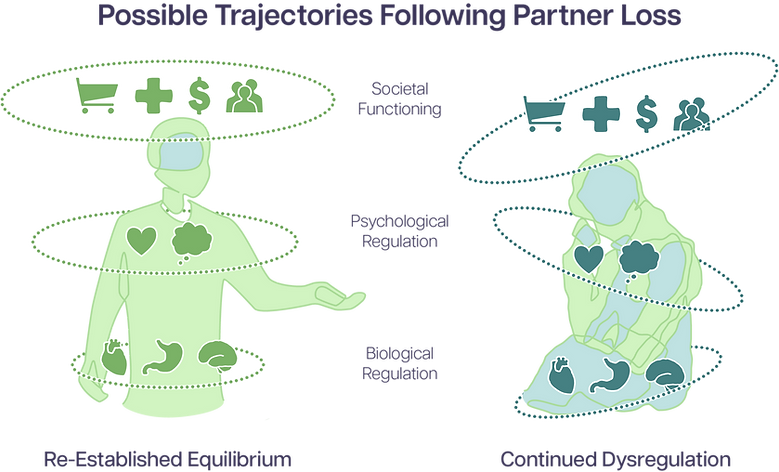The loss of a long-term partner can be a profoundly painful, stressful, and disorienting experience. At the STAR lab we aim to build a clear picture of how experiences of both partnership and partner loss impact individuals across all life domains (biological, psychological, societal). We hope that in doing so we can better understand the fundamental human experiences of love and loss, and support well-being in the face of loss.
Healthy long-term romantic relationships serve as powerful stabilizing forces in the lives of partnered individuals, with far-reaching effects across biological, psychological, and societal domains. Within partnership, individuals co-regulate on biological (e.g., parasympathetic nervous system regulation) and psychological levels (e.g., emotion and stress regulation) and share in the coordination of societal demands (e.g., management of financial, household, and social responsibilities) — together these established co-regulation and co-functioning processes give rise to shared life architectures: interdependent systems that support and stabilize individual well-being and mitigate the stress of daily life. When a partner is lost, these shared life architectures are also lost, and individuals often experience a period of expected dysregulation (i.e., grief, sleep disturbances, difficulty focusing, heightened stress responsivity, etc.).

Following the loss of a long-term partner, an individual faces the challenge of finding a new equilibrium, adjusting their regulation and functioning across all levels of their life (biological, psychological, societal) in order to re-establish a stable foundation. At the STAR lab we would call this process re-establishing equilibrium (encompassing re-regulation and re-oriented societal functioning). If an individual struggles to regain equilibrium following partner loss (continued dysregulation), they may experience not only continued grief, compounding stressors and life maintenance disruptions, but also additional physical health challenges associated with chronic dysregulation (e.g., cardiovascular disease).

How does one re-establish their equilibrium following partner loss? It may look different for different people, but the core idea is this: reorganizing one’s life requires re-establishing a stable foundation for oneself across biological, psychological, and societal domains. This may mean prioritizing sleep to support one’s immune system health, figuring out how to emotionally regulate oneself effectively, reaching out to existing friends and family for support, and/or establishing new relationships.
Who is more vulnerable to continued dysregulation? We do not have a clear answer to this yet, but our lab (and others) are actively working on this with early data pointing to the importance of biological and psychological responses to stressors. As a result, our lab often focuses on dysregulated stress-response processes to better understand the early signs of who may struggle to regain stability in the absence of the stabilizing force of their partner.

In sum, at the STAR Lab, we aim to map the complex ways in which partnership and partner loss shape individual lives. Our goal is to better understand how people navigate the major transitions that follow loss with the hope of identifying diverse pathways that can support well-being and healthy aging despite loss.
Highlighted Work
In the STAR Lab, we focus on partner loss in context, which means we use one’s social context as a primary lens through which to understand how the loss of a partner may be affected by, and affect, the broader context of one’s life.
The following are several areas we’re actively investigating in the STAR lab:
Stress Responsivity.
How do stress-response processes early in widowhood contribute to the likelihood of continued dysregulation? Click here for an example of this research published in Psychological Science.
Socioeconomic Resources.
How is the widowhood transition experienced differently based on one’s socioeconomic resources (e.g., total wealth, educational attainment)?
Click here for an example of this research published in Comprehensive Psychoneuroendocrinology.
Emotion Regulation.
How can the science of emotion regulation help us understand who may be more vulnerable to continued dysregulation when facing waves of grief, new roles and responsibilities, and the stressors of daily life?
Click here for an example of this research published in Health Psychology.
Interested in learning more? Check out our full list of publications here.
You can also learn more about our team here.
© The STAR Lab. [This content was designed in collaboration with Thoughtscape Inc.]







